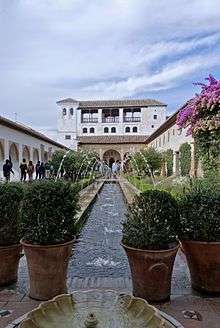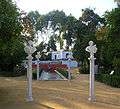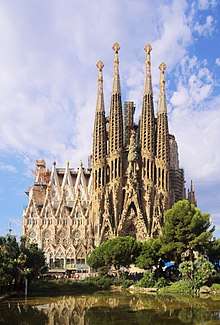Spanish garden
A traditional Spanish garden is a style of garden or designed landscape developed in historic Spain, incorporating principles and elements of garden design from precedents in ancient Persian gardens, Roman gardens and Islamic gardens, and the great Moorish gardens of the Al-Andalus era on the Iberian Peninsula. In the 20th and 21st centuries a 'Spanish Garden,' or new gardens in Spain, have continued, interpreted, abstracted, or departed from these traditional planning and aesthetic motifs.

Traditions
Traditionally, the paradise garden is interpreted with a central cross axis, in the four cardinal directions, with long ponds or water channels (a rill or stylized qanat) where water reflects and flows, set in a walled courtyard. The remaining quadrants often had fruit trees and fragrant plants. Thus, characteristic sensory experiences are refreshing coolness, humidity, sounds, greenery, and fragrance. This type of garden is compatible with the Spanish climate of sun and heat. Provisions for shade are given with the use of arcades, pergolas, trellising, and garden pavilions. Ceramic elements and tiles are often used: in water features; for structural, decorative, and seating elements; and as paving; with solid fields, embellishments and accents; and in pottery. A clarity from the symmetrical simplicity often results.[1]
Historical design eras
Spain has a long tradition of making gardens. Significant gardens were made by:
- immigrants from the Carthaginian and Roman Empires; for example, the Palmeral of Elche in Alicante
- nobility, Christians in the Spanish Medieval period
- Islamic rulers and artisans of Al-Andalus, the Moorish Iberian Peninsula or Spanish territories, especially in present-day Andalusia in Southern Spain; for example, the Alhambra, Generalife in Granada.[2]
- post-Reconquista Mudéjar design and artisans; for example, the Alcázar of Seville.[3]
- catholic monarchs during the Spanish Renaissance, Spanish Gothic, and Spanish Baroque periods; for example, the Royal Palace of La Granja de San Ildefonso.
- landowning and business dynasties during the Romantic and Modern periods; for example, Park Güell.
- civic projects and expositions; for example, Maria Luisa Park and Plaza de España in Seville.
- In 21st century Spain, gardens are designed by garden and landscape designers, horticulturalists, artists, architects, and landscape architects; for example, the Olympic village public outdoor spaces for the 1992 Barcelona Olympics or the public spaces for the Universal Exposition of Seville Expo '92.
Many historic gardens are protected by a heritage designation, Jardín histórico.
Gallery
 Garden of the Lions from Maria Luisa Park
Garden of the Lions from Maria Luisa Park- Gardens from Alcázar of Seville.
- Maria Luisa Park, Seville
 Jardín de la Alhambra
Jardín de la Alhambra Jardín del Alcázar de Sevilla
Jardín del Alcázar de Sevilla.jpg) Jardín del Alcázar de Córdoba
Jardín del Alcázar de Córdoba Jardín del Museo Sorolla de Madrid
Jardín del Museo Sorolla de Madrid- Jardín de la Alcazaba de Málaga
 Jardines de las Delicias de Sevilla
Jardines de las Delicias de Sevilla- Jardín del Alcázar de Jerez
- Bird nests built by Gaudí in the Park Güell terrace walls.
See also
Notes
- Segall (1999), pp. 8–10
- Goodwin (1990), pp. 1–13
- Goodwin (1990), pp. 13–17
References
- Correcher, Consuelo (1993). The Gardens of Spain. Harry N. Abrahms. ISBN 0-8109-3370-5.
- Segall, Barbara (1999). The Garden Lover's Guide to Spain and Portugal. Princeton Architectural Press. pp. 8–10. ISBN 1-56898-161-9.
- Goodwin, Godfrey (1990). Islamic Spain. Chronicle Books. ISBN 0-87701-692-5.
| Wikimedia Commons has media related to Moorish gardens in Spain. |

